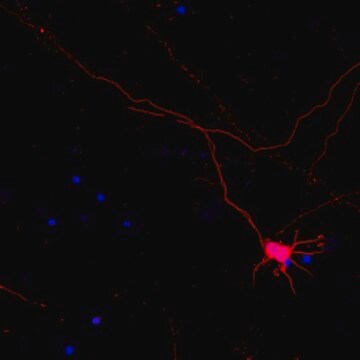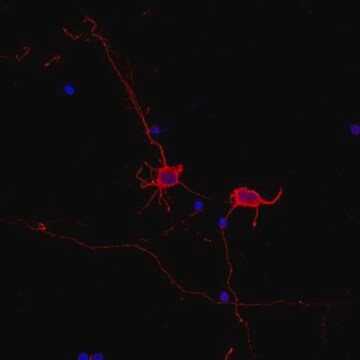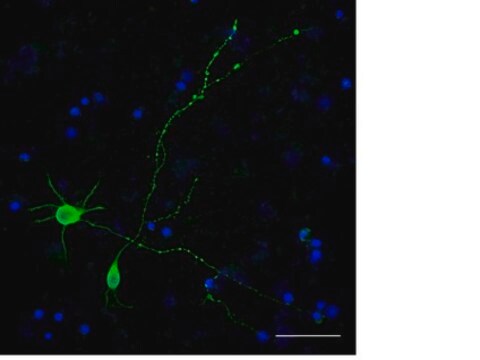ABN2300A4
Neuro-Chrom Pan Neuronal Marker Antibody-Rabbit, Alexa488 conjugate
Neuro-Chrom, from rabbit
Sign Into View Organizational & Contract Pricing
All Photos(3)
About This Item
UNSPSC Code:
12352203
eCl@ss:
32160702
NACRES:
NA.41
Recommended Products
biological source
rabbit
Quality Level
conjugate
ALEXA FLUOR™ 488
clone
polyclonal
species reactivity
mouse, rat
manufacturer/tradename
Neuro-Chrom
technique(s)
immunocytochemistry: suitable
immunofluorescence: suitable
immunohistochemistry: suitable
shipped in
wet ice
target post-translational modification
unmodified
General description
Antibodies to neuronal proteins have become critical tools for identifying neurons and discerning morphological characteristics in culture and complex tissue. While the labeling from classic histological techniques such as Golgi staining and modern molecular approaches such as GFP constructs yield excellent cytoarchitectural detail, these approaches are technically challenging and impractical for many neuroscience research needs. Neuron-specific antibodies are convenient precision tools useful in revealing cytoarchitecture, but are limited to the protein target distribution within the neuron, which may differ greatly from nucleus to soma to dendrite and axon. To achieve as complete a morphological staining as possible across all parts of neurons, Millipore has developed a polyclonal antibody blend that reacts against key somatic, nuclear, dendritic, and axonal proteins distributed across the pan-neuronal architecture that can then be detected by a single secondary antibody. This antibody cocktail has been validated in diverse methods, cell culture and immuno-histochemistry, giving researchers a convenient and specific qualitative and quantitative tool for studying neuronal morphology.
Specificity
Cat. # ABN2300A4 is specific to axons (neurites), dendrites, nucleus, and the cell body of neurons.
Reactivity with other species has not been determined.
Immunogen
Epitope: Whole Neuron Marker
Application
Neuro-Chrom Pan Neuronal Marker-Rabbit, Alexa488 conjugate is an antibody targeting the Pan Neuronal Marker protein, validated for use in ICC, IHC & IF.
Research Category
Neuroscience
Neuroscience
Research Sub Category
Neuronal & Glial Markers
Neuronal & Glial Markers
Quality
Routinely tested Rat E18 cortex primary neurons in Immunocytochemistry.
Physical form
Polyclonal antibody cocktail blend conjugated to Alexa Fluor™ 488 in PBS buffer with 15mg/mL BSA and 0.05% NaN3
Storage and Stability
Maintain at 2-8°C for up to 1 year from date of receipt.
Analysis Note
Control
Rat E18 cortex primary neuron cell culture or mouse adult brain cryosections.
Rat E18 cortex primary neuron cell culture or mouse adult brain cryosections.
Legal Information
ALEXA FLUOR is a trademark of Life Technologies
Disclaimer
Unless otherwise stated in our catalog or other company documentation accompanying the product(s), our products are intended for research use only and are not to be used for any other purpose, which includes but is not limited to, unauthorized commercial uses, in vitro diagnostic uses, ex vivo or in vivo therapeutic uses or any type of consumption or application to humans or animals.
Storage Class Code
12 - Non Combustible Liquids
WGK
WGK 2
Flash Point(F)
Not applicable
Flash Point(C)
Not applicable
Certificates of Analysis (COA)
Search for Certificates of Analysis (COA) by entering the products Lot/Batch Number. Lot and Batch Numbers can be found on a product’s label following the words ‘Lot’ or ‘Batch’.
Already Own This Product?
Find documentation for the products that you have recently purchased in the Document Library.
Xinhua Zhan et al.
Neurology, 87(22), 2324-2332 (2016-10-28)
We determined whether Gram-negative bacterial molecules are associated with Alzheimer disease (AD) neuropathology given that previous studies demonstrate Gram-negative Escherichia coli bacteria can form extracellular amyloid and Gram-negative bacteria have been reported as the predominant bacteria found in normal human
Andreas C Woerner et al.
Science (New York, N.Y.), 351(6269), 173-176 (2015-12-05)
Amyloid-like protein aggregation is associated with neurodegeneration and other pathologies. The nature of the toxic aggregate species and their mechanism of action remain elusive. Here, we analyzed the compartment specificity of aggregate toxicity using artificial β-sheet proteins, as well as
Our team of scientists has experience in all areas of research including Life Science, Material Science, Chemical Synthesis, Chromatography, Analytical and many others.
Contact Technical Service








